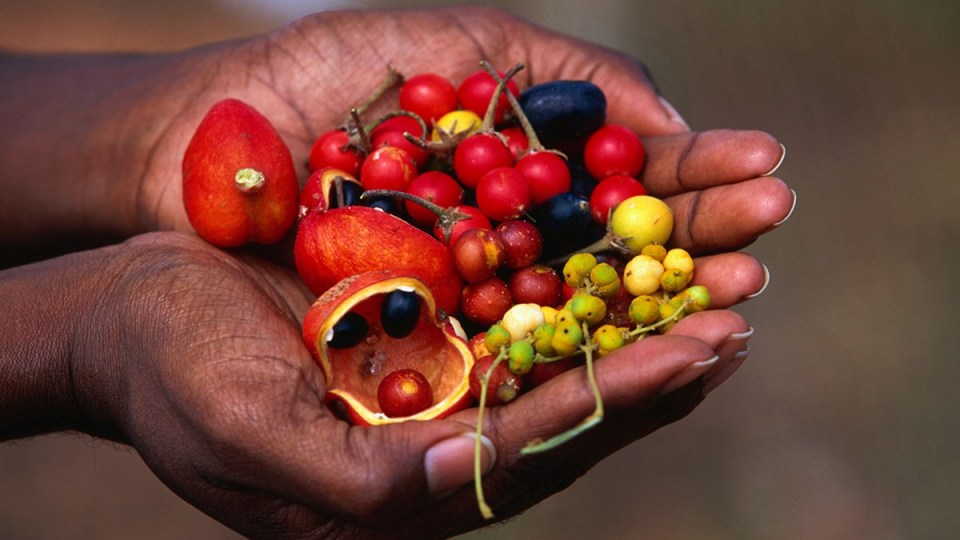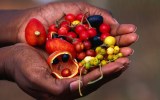


What do a rainforest leaf, a toxic fern, and an ancient palm have in common?
They each reveal the ingenuity of Australia’s Aboriginal and Torres Strait Islander peoples, who for tens of thousands of years have known how to turn native plants into delicious bush food, flavour, and medicine.
This is science. It’s grounded in careful observation, rigorous experimentation, and systems of knowledge passed down through story, song and practice. And it’s deeply relevant today.
As we confront challenges like climate change and food insecurity, Indigenous science offers both ancient wisdom and cutting-edge insight.
As we confront challenges like climate change and food insecurity, Indigenous science offers both ancient wisdom and cutting-edge insight.
The chemistry of a leaf, the safe preparation of a fern, the detoxifying of a seed – these aren’t relics of the past.
They’re blueprints for a sustainable future, born of deep knowledge, patient experimentation and respect for Country1. It’s time we listened, learned, and fully acknowledged their valuable contributions.
The chemistry of bush flavour
Lemon myrtle (Backhousia citriodora F. Muell.) is one of Australia’s most aromatic native plants.
With a flavour that’s often described as ‘lemonier than a lemon’, it owes its intense citrus hit to a compound called citral — a natural chemical also found in lemongrass and lemon balm.
Citral is what gives lemon myrtle its signature tang, delivering a pure, intense citrus note without the acidity of citric acid (unlike in lemons), making it ideal for balancing dishes without altering their pH. Citral also imparts potent antimicrobial and antioxidant properties.
Citral is actually made up of two chemical compounds called isomers. These are Geranial (Citral A) and Neral (Citral B) which are used in fragrances, flavours and other applications.
Aboriginal Australians have used lemon myrtle (a key species in their Customary Medicinal Flora) for thousands of years, not just as a flavouring but also for medicinal purposes – as a soothing tea for coughs and colds, or crushed in water for cleansing and healing.
Long before modern chemistry confirmed its active compounds, First Nations communities recognised its effectiveness through observation and use.
The choice to use lemon myrtle – and how it was prepared – reflects a deep understanding of plant chemistry.
Whether selecting leaves at their most fragrant stage or knowing where the plant grows best, this knowledge wasn’t random. It was science, tested over generations, refined through experience, and passed down through story and practice.
Nowadays, lemon myrtle has become a bush tucker favourite, lending its bold flavour to teas, desserts, spice blends, and even cheeses. And it’s frequently found in cleaning and personal care products.
Its growing popularity is a reminder that the oldest knowledge systems on this continent are not only still relevant — they’re leading the way in flavour, health and sustainability.
How to eat a fern without dying
Aboriginal and Torres Strait Islander peoples not only have a deep understanding of nutrition, their ancestral knowledge includes detailed and precise knowledge about safe plant preparation. Several historical accounts illustrate this perfectly.
When the ill-fated explorers Burke and Wills ran low on supplies, the local Yandruwandha people gave them food, including damper made from the sporocarps of an aquatic fern called nardoo (Marsilea drummondii).
Aboriginal people knew how to produce flour from nardoo’s spore-producing structures. However, Burke and Wills later ate them raw.

In late June, 1861, Burke and Wills died of malnutrition despite having food to eat.
The mystery lay in an enzyme called thiaminase, found in nardoo. Thiaminase breaks down vitamin B1 (thiamine) in the body, leading to a dangerous deficiency, called beriberi, that affects the nervous system.
Symptoms can include fatigue, confusion, nerve damage and, if untreated, death. The Yandruwandha people knew this — not through textbooks, but through generations of careful practice. They had developed methods to process nardoo properly, such as soaking, leaching and roasting, which deactivated the toxin.
The Burke and Wills tragedy is often remembered as a story of hardship and failed exploration, but it’s also a story of overlooked wisdom.
What the explorers lacked wasn’t just food, but understanding. The science of how to safely eat nardoo was already known, encoded in the lived experience of the people who had thrived in that landscape for millennia.
Today, there are many commonly eaten foods that require special preparation to ensure they’re safe for human consumption, including cassava, taro, and kidney beans.
Nardoo is just one example of how Indigenous science, grounded in observation and experience, protected communities long before modern toxicology existed — and like those other foods that require careful preparation, it still has potential to enrich modern diets today.
Cycads, Captain Cook, and consequences
Cycads offer another example of Indigenous knowledge of safe preparation practices.
The ancient, seemingly palm-like plants found across northern Australia contain toxic compounds like cycasin, which can cause vomiting, liver damage, and even death if not properly treated.

Indigenous Australians have long consumed cycad seeds, but only after careful processing. The seeds are soaked in running water, leached of toxins, and ground or cooked in specific ways, often over multiple days. This methodical approach renders them safe and nutritious, unlocking their starchy energy stores.
But when colonists and early explorers encountered cycads without access to this knowledge, the results were dangerous. Historical accounts suggest that several members of Cook’s crew and other expeditions suffered illness after consuming improperly prepared seeds — mistaking them for a convenient bush food after finding the hulls around Aboriginal campfires.
Much like with nardoo, the issue wasn’t the plant — it was the failure to heed the science embedded in Indigenous practice. These stories underscore how knowledge held by Aboriginal and Torres Strait Islander peoples is not only deeply tied to Country, but also grounded in chemical insight, food safety, and adaptive science.
Science in storytelling — Knowledge passed through generations
For First Nations peoples, science isn’t just found in textbooks — it lives in stories, songs, ceremonies and careful observation. These cultural traditions are scientific records, preserving knowledge of plant chemistry, seasonal change and ecological relationships with precision.
A man of the First peoples of Australia performing a ritual medicine dance. Credit: Getty.
Children learn through watching and listening: which plants to eat, how to process them, when to harvest, and when to wait. These lessons are grounded in generations of trial and observation, embedded in systems of respect and responsibility.
Knowledge like how to detoxify nardoo or prepare cycads isn’t abstract — it’s culturally embedded science. It teaches not just how, but when, where, and whether to act.
In this way, Aboriginal science passes down more than facts — it passes down wisdom. And that wisdom has endured, in practice and in memory, for tens of thousands of years.
“Given the wealth of knowledge held by the Indigenous People of Australia, the term Customary Knowledge now recognises that this knowledge incorporates traditional and contemporary knowledge,” says Professor Sylvia Urban, Program manager of the Bachelor of Science and Reconciliation and Responsible Practice Facilitator for the School of Science (STEM College), RMIT University.
“The term Customary knowledge of Australian medicinal flora is used to describe the field of research that focuses specifically on the phytochemical (chemistry and bioactivity) of compounds in Australian plants.”
Indigenous food systems and future sustainability
Australia’s Indigenous food systems are among the oldest in the world — and some of the most sustainable. Developed over 60,000 years, they’re tailored to this continent’s landscapes, offering vital lessons for today’s climate-challenged world.
Bush foods like wattleseed, bush tomato, and native yam thrive with little water, no chemicals and minimal intervention. Many are nutrient-dense and climate-resilient, making them ideal for diversifying modern diets.
Lemon myrtle, for example, is rich in antioxidants and citral, with uses ranging from teas to cleaning products.
Modern science is only now uncovering what Aboriginal communities have long understood: these systems are sophisticated, sustainable, and deeply rooted in care for Country.
But the value of Indigenous food systems isn’t just in ingredients — it’s in ethos. Practices like seasonal harvesting, firestick farming, and communal custodianship protect biodiversity and Country while maintaining productivity.
The system is circular, respectful, and rooted in the long view — something industrial agriculture struggles to replicate.
As we search for more sustainable ways to grow and eat, Indigenous science offers both practical solutions and a guiding principle: sometimes the most powerful innovations are already here — if we choose to listen.
“Australia is a globally recognised biodiversity hotspot, home to countless unique species of flora and fauna. This presents an incredible opportunity for research and sustainable development,” says Associate Professor Tien Huynh, Biotechnology Program Manager at RMIT University (School of Science).
“By embracing the deep traditional knowledge of our Indigenous custodians, we can build on centuries of wisdom rather than starting from scratch, and co-developing solutions that help make our planet cleaner, greener, and healthier for all.”
(Warning: Never taste an unfamiliar plant unless someone who knows the plant well has told you it’s safe to eat.)
The article first appeared in Cosmos Magazine. Read the original here.











